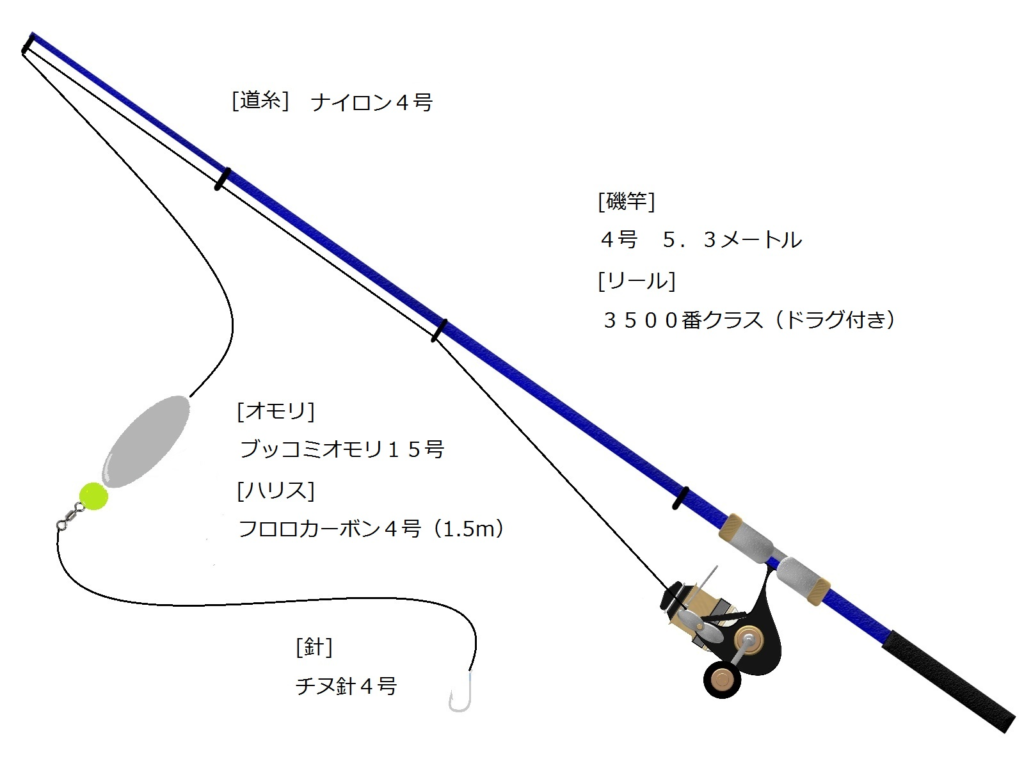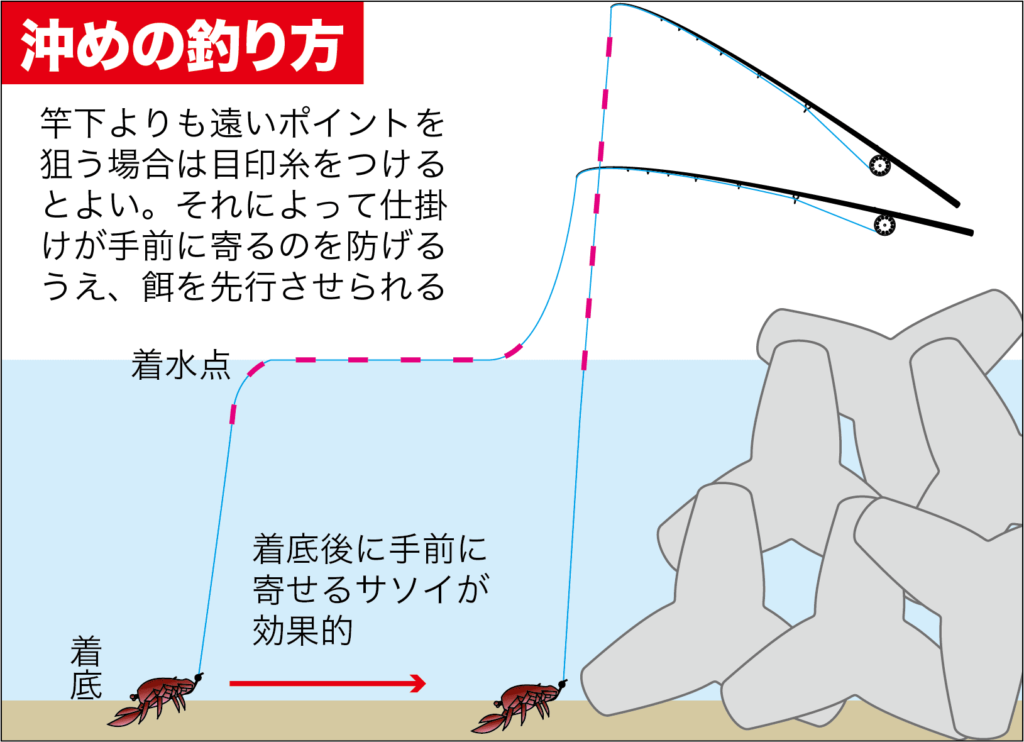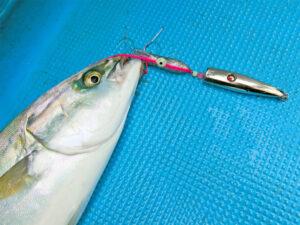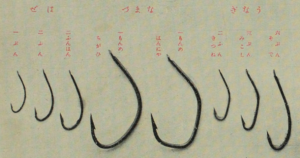Angling for Kurodai, Blackhead Seabream
Kurodai has been a very popular target fish for anglers. This fish lives close to the shore, dwells in various types of coast, and feeds on many kinds of food sources. It makes the fish a good game fish, for which anglers try to catch in various fishing methods.

Species
Kurodai (Blackhead seabream, Acanthopagrus schlegelii) is a species under the Sparidae family. It lives along the coast of East Asian countries. The northernmost area in which this fish dwells is Hokkaido island, and the southern limit is in the coast of Taiwan.
While the many of Sparidae family fish tend to live in the deep, Kurodai stays within the shore to 50 m depth range. It can survive well in the brackish water or it can be seen in waters, which is almost freshwater. For this character, Kurodai is called Kawa-dai (literal meaning; River seabream) in Noto peninsula. There was a record that this fish was found in the river 7 km away from the sea, following Ayu (Ayu sweetfish, Plecoglossus altivelis) as bait fish, in Hiki-river. It can adapt to the environment with lower quality water (even polluted water.) Even in the industrial port, such as deep in Tokyo bay and Osaka bay, you can find this seabream.
Kurodai are omnivorous to eat the various kinds of bait available. If you list their food sources, it becomes a very long one. Sea worms (Hediste, Eunicida), crustaceans (shrimps, crabs, mantis shrimps, mud shrimps, acorn barnacles, sea roaches, etc.), shells (mussels, oysters, clams, etc.), fish (sardines, jack mackerels, etc.) sea weeds (gulf weed, kelps), vegetables and fruits (corn, watermelon, satsuma orange etc.)
Modern angling styles for Kurodai
As this fish is in various environmental situations and feeding on many kinds of bait, the angling methods are also full of varieties.
These are popular methods to catch Kurodai.
- Lure fishing (from bottom bumping to top water)
- Iso Fukase style (float fishing with chumming)
- Cast and wait style
- Otoshikomi-zuri (or Hechi-zuri, catching fish with free-falling hooked mussel)
- Maeuchi (shallow bottom fishing, mostly using crabs for baits)
- Dango with float (float fishing with dumpling of paste bait)
- Kakari-zuri (or Ikada-zuri, bottom fishing with dumpling of paste bait, especially from floating pier)
These are not extensive, and there are more local angling styles.
1. Lure fishing
Since Kurodai feed on almost any depth near the coast, you can say almost any lure fishing styles can be applicable for this fish. The most popular way is night fishing with bottom bumping. Lures for it are rubber jigs or jig heads with soft lures (like hogs type).
2. Iso Fukase style
The Iso Fukase style for Kurodai is similar to the one for Mejina (shown in this article of mine about details.) The main difference between these two targets is that Iso Fukase for Kurodai is more static and sensitive.
This style uses the thin and long floats as well as round shape floats. This float is easy to detect the bite and has less resistance to allow it to bite naturally. It can be done with the krill on the hook, with chunming of krills. In some occasions the paste bait is used, as well.

3. Cast and wait style
Kurodai feeds on the bottom, and it makes naturally this casting style one of the methods to catch it. Rigs are simple. The key for success is the selection of bait.
Because this fish eats many kinds of foods, to match the preference in the time of fishing is very important.

4. Otoshikomi-zuri
This style is to present the fish hooked bait along the pier walls..

This traditional style of fishing uses the Japanese style (rather parabolic action) rod of 2.1 m to 3.6 m, with a sensitive tip. Lines are 2 to 3 gou (0.24 mm to 0.28 mm thickness) of nylon for the main line (in fluorescent color or with markers,) and the fluoro line of 0.17 mm to 0.24 mm is for hook leader. And the hook has a split shot of a few grams.
We have a special type of reel for this fishing. It appears similar to a fly reel, but without click nor drag.

Baits are mussels and crabs to search along the pier wall and crabs to search the bottoms. For the mussel bait, it is important to let the shell fall in the natural way, while you are ready to detect the bite properly. Bites can be detected with the movement of the main line or the slight tip movement.

5. Maeuchi
This Maeuchi fishing is targeting the bottom in rod reaching distances using crabs, shrimps and mussels as hooked bait. Rig is very similar to Otoshikomi, but the rod tends to be longer and up to 4.5 m.

6. Dango with Float
Dango means dumpling in Japanese. And we call a fishing style which uses dumplings, made of paste bait, Dango fishing. This is a sort of float fishing, and the total rig is almost the same as Iso Fukase style,
The hooked bait (krills, stickier paste bait, shrimps, chrysalis of silkworm etc.) is embedded within a dumpling. And it is thrown into the water. The dumpling sinks down to the sea floor with the bait, then as the dumpling is melting or broken down, it attracts fish and exposes the bait.

The convenient point of this Dango style is that it assures the fishing on the bottom of the sea and spreads the attractants there.
The ingredients of dumpling are powder rice bran (to make the bait sticky and produce cloud in the water), sand (to make the mixture heavier), ground dried silkworm chrysalis (to attract fish), rolled barley (to make whitish cloud in the water, to have a visible luring material), and artificial attractants.

7. Kakari-zuri (or Ikada-zuri)
This is one of the styles for Kurodai using dumplings. But this Kakari-zuri style does not use floats and it is done from the floating pier (called Kakari or Ikada)
The rig of this fishing style is very simple.
A short rod with a very sensitive tip, of 1.4 - 1.8 m. The main line is 2 gou (0.24 mm thickness), nylon or fluoro (fluoro can be thinner) and the hook leader is 2 gou of fluoro.

This style developed one particular type of reel, as shown in the image below.

This reel is called Ikada reel in Japan. Its concept is to have extra fast gearing on a free rotating centerpin reel. The spool of this reel is held only by one side of the axle, to make the lightest free rotation. This free rotation is important to let the dumpling sink without any stress through the line. The gears are installed on the handle side. Though the spool diameter is about 60 to 65 mm, with over 5.0 gear ratio, its retrieval length reaches at about 75 cm per handle turn.
Baits are krills, shrimps, mussels, dried chrysalis of a silkworm, etc. and this hooked bait is embedded within the dumpling. Dumpling’s ingredients are almost the same as Dango with a float, but the dumplings tend to be heavier or denser.
This Kakari-zuri is mostly done on the floating pier, like the one you can see in the below image.

This floating pier is often made for the fish farming (or shell farming) facility, originally. But currently there are many of such floating piers used for fishing or leisure usage. This type of pier is called Kakari (or Ikada), in some regions, and it is the origin of the name of this fishing style.
The basic concept of Kakari-zuri is also close to float-Dango fishing. You sink the total dumpling to the bottom, with the hooked bait, then you wait for the dampling to be broken down. Instead of throwing the dumpling you do in float Dango, in this Kakari-zuri, the dumpling is sunk vertically.

These are some famous fishing methods for Kurodai, in Japan.
As this fish was a very accessible fish, people must have been enjoying fishing for it for a very long time. This history brought us various ways to catch them.
The characteristics of Kurodai may be similar to some of the target species in your country. If so, then why don’t you try some of the above methods in your waters?

